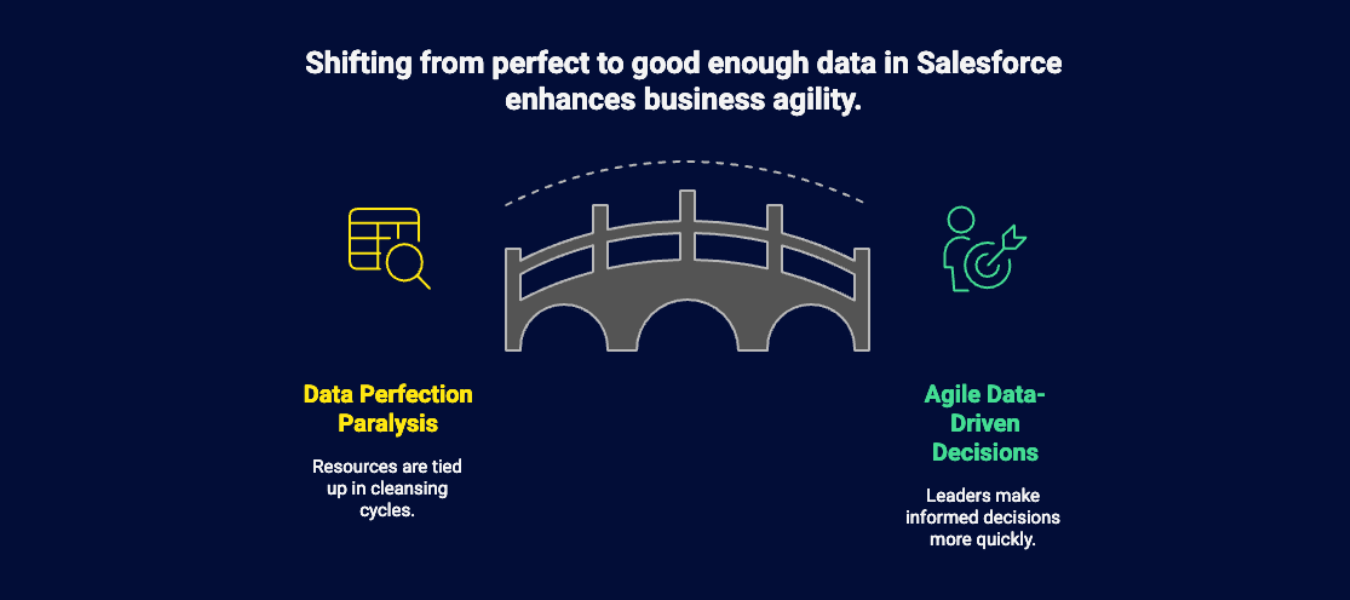
In today’s fast-paced business environment, the pressure to leverage data for strategic advantage is immense. For organizations relying on Salesforce, this often translates into an intense focus on data quality. While the pursuit of clean, accurate, and complete data is undeniably important, Xccelerance Technologies observes a growing trend: the quest for “perfect” data can become a paralyzing endeavor, hindering the very agility it aims to support. This article challenges the conventional wisdom, arguing that a pragmatic approach – striving for “good enough” data – is often the more effective path to speed, usability, and ultimately, business success.
The desire for pristine data is understandable. Poor data quality carries a significant price tag, with Gartner estimating it costs organizations an average of $12.9 million annually. Inaccurate or incomplete Salesforce data can lead to flawed decision-making, inefficient operations, and missed revenue opportunities. Salesforce’s own research highlights that 65% of sales professionals can’t completely trust their organization’s data, citing incomplete data (38%), data stored in multiple formats (37%), and data not updated regularly (37%) as primary reasons. Furthermore, data decay is a relentless force, with estimates suggesting an average annual decay rate of B2B contact data around 25-30%. Some sources even state this decay can reach as high as 70.3% per year.
These statistics paint a stark picture and often fuel an all-or-nothing approach to data quality. However, the pursuit of absolute data perfection can lead to diminishing returns and unintended negative consequences.
The Paralysis of Perfection
Chasing flawless data in a dynamic system like Salesforce can create significant bottlenecks. Resources become tied up in endless cleansing cycles, complex validation rule implementations, and the pursuit of 100% completeness for every data field. This can slow down critical business processes, delay the rollout of new initiatives, and frustrate users who are often burdened with cumbersome data entry requirements.
Consider the implications for innovation. If launching a new marketing campaign or deploying an AI-driven sales tool is contingent on achieving “perfect” data, these initiatives can be stalled indefinitely. The reality is that data is constantly in flux; people change jobs, companies restructure, and new information emerges daily. Aiming for an eternally perfect dataset is like trying to hit a continuously moving target.
The pressure to achieve perfection can also foster a culture of fear around data. If employees are overly concerned about the repercussions of imperfect data entry, they may become hesitant or less productive. Ironically, this can sometimes lead to data being fabricated or manipulated to meet unrealistic quality standards, as highlighted by a Validity study where 75% of respondents admitted staff “often” or “sometimes” fabricate data.
The Power of “Good Enough” Data
Adopting a “good enough” data strategy doesn’t mean abandoning data quality. Instead, it advocates for a pragmatic and context-driven approach. The key is to identify the critical data elements that have the most significant impact on specific business outcomes and focus resources on ensuring their accuracy, completeness, and timeliness.
What does “good enough” look like in practice?
- Prioritization based on business impact: Not all data is created equal. For a sales team, accurate contact information and opportunity stage might be paramount. For marketing, clean email addresses and campaign engagement data are crucial. Focus efforts on the data fields that directly drive revenue, customer satisfaction, or operational efficiency. As one Salesforce article notes, business initiatives should take precedence over data initiatives.
- Iterative improvement over exhaustive cleansing: Instead of aiming for a one-time, massive data cleanup, implement ongoing, incremental improvements. Focus on preventing bad data at the point of entry through well-defined processes, user training, and sensible validation rules. Strategic implementation of validation rules can prevent the input of dirty data at the source, reducing the need for extensive cleansing activities later on.
- Fitness for purpose: The definition of “good enough” can vary depending on the use case. Data used for high-level trend analysis may not require the same level of granular accuracy as data used for personalized customer communication or financial reporting. Even with imperfect data, valuable insights can be gained, and data clean-up can be a parallel conversation, not a roadblock.
- Focus on usability and speed: Data is only valuable if it can be accessed and utilized efficiently. Overly complex data models or excessively stringent data entry protocols can hinder usability. A “good enough” approach prioritizes making key data readily available to those who need it, when they need it, to make timely decisions.
- Leveraging technology smartly: Utilize Salesforce’s built-in tools for duplicate management and validation, and consider third-party solutions for data enrichment and cleansing where the ROI is clear. Automation can play a significant role in maintaining a “good enough” standard without excessive manual effort.
Embracing Agility through Pragmatism
The shift from chasing “perfect” data to embracing “good enough” data is a cultural one that requires a change in mindset from the top down. It acknowledges that data quality is an ongoing journey, not a final destination. By focusing on pragmatic data quality strategies, organizations can:
- Accelerate speed to market: Launch new products, campaigns, and initiatives faster without being bogged down by unattainable data perfection goals.
- Improve user adoption and productivity: Simpler data processes and a focus on essential data points can reduce user frustration and increase the overall usability of Salesforce.
- Enable data-driven decision-making sooner: Access to reasonably accurate and timely data allows leaders to make informed decisions more quickly, even if the dataset isn’t flawless. 73% of business leaders agree that data helps reduce uncertainty and make more accurate decisions.
- Foster a culture of continuous improvement: Regularly assess data quality against business needs and make targeted improvements, rather than striving for an elusive ideal.
While the headlines about the cost of bad data are compelling, it’s crucial to avoid letting the pursuit of perfection become the enemy of progress. In the context of Salesforce, “good enough” data, strategically managed and fit for purpose, is often the true key to unlocking business agility and driving meaningful results. Xccelerance Technologies encourages leaders to challenge the status quo and consider if their current data quality initiatives are enabling speed or inadvertently creating friction. The answer might be surprisingly liberating.


